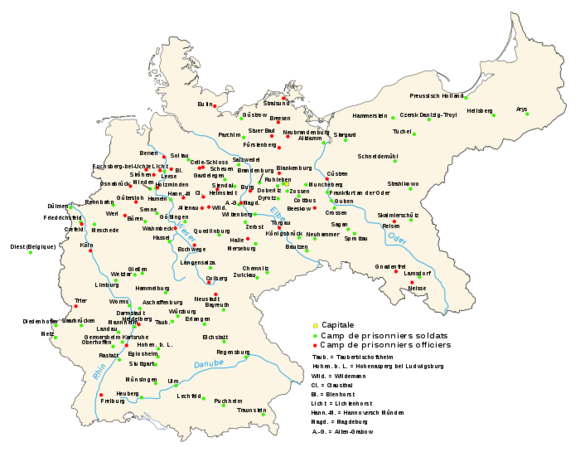- Profile
- Images
Location: [unknown]
- WikiTree Profiles Roll of Honor
- Prisoner of War/Missing in Action
- American Civil War POW Camps
- Japanese POW Camps WW11
- Vietnamese POW Camps (1964-1973)
- Allied POW Camp
A POW Prisoner of War is a person, whether combatant or non-combatant, who is held in custody by an enemy power during or immediately after an armed conflict.
German POW Camps WW1
There were more than 1.3 million prisoners held in Europe in the first 6 mths of WW1 accommodating so many POWs was a huge problem for all countries involved allegations of cruelty and neglect were commonplace.Treaties covering the treatment of POWs were agreed before the war (the Hague and Geneva Conventions), but German propaganda reported widely on the brutality of Allied camps to encourage their soldiers to fight to the death as a preference to being captured. Likewise in Britain it was claimed that Allied prisoners in Germany were systematically persecuted by order of the German government Inspectors from neutral countries were called upon to check on camp conditions.
When war was declared in 1914, there was no system in place on either side for dealing with POWs camps were hastily set up according to need many camps were built from scratch but existing buildings were also utilised. The early camps were found to be over-crowded, though this situation improved in Britain once makeshift camps were replaced. Complaints about German camps centred on inadequate sanitation, housing and food (for which the Allied naval blockade was partly responsible), the nature of work assigned to prisoners and the brutal behaviour of the guards POWs in Turkish camps except for officers, were treated particularly harshly

| Name and Site | Notes on Camp |
|---|---|---|
| Germany | Altdamm Dąbie Szczecin, Poland | Three camps holding 15,000 men. |
| Germany | Bad Langensalza Unstrut-Hainich, Thuringia, Germany | Opened in 1914, the camp held 10,000 men. |
| Germany | Czersk Poland | Prisoner camp located around Łukow passed about 50,000 war prisoners mainly Russian British prisoners were also later sent. |
| Germany | Döberitz Brandenburg | The POW camp attracted worldwide press attention after British Private William Lonsdale punched a German guard in November 1914 and was sentenced to death. Lonsdale and 250 fellow captives had failed to assemble quickly enough for the Germans and a general fracas then erupted between British prisoners and the guards. Bowing to international pressure, the death sentence was commuted to 20-years in January 1915, followed by an outright pardon from the Kaiser, seizing the propaganda opportunity. |
| Germany | Frankfurt on OderBrandenburg, Germany | Four miles from the town, holding 18,000 men |
| Germany | Gardelegen Saxony-Anhalt, Germany | Camp opened in September 1914. |
| Germany | Gleiwitz Poland | Located in a cavalry barracks. British prisoners sent there after March 1918. |
| Germany | Grabow Mecklenburg-Western Pomerania, Germany | Formerly a military camp, consisting of eight compounds of six barracks each. |
| Germany | Güstrow Mecklenburg-Western Pomerania, Germany | Situated in pine-woods three miles from the town. It held 25,000 men, but had another 25,000 registered there assigned to work camps. |
| Germany | Holzminden prisoner-of-war camp Holzminden Germany | For British officers it opened in September 1917, and closed with the final repatriation of prisoners in December 1918. It is remembered as the location of the largest PoW escape of the war in July 1918, 29 officers escaped through a tunnel, of whom ten evaded subsequent recapture and managed to make their way back to Britain |
| Germany | Kalisz Greater Poland Voivodeship | Camp for Russian and Romanian soldiers, and also British from April 1918. |
| Germany | Kassel Hesse Germany | (Niederzwehren) Held 20,000 POW |
| Germany | Königsbrück Saxony Germany | Held 15,000 men |
| Germany | Limburg an der Lahn | During World War I there was a major prisoner of war camp at Limburg an der Lahn holding 12,000 men Many Irish members of the British Army were interned there until the end of the war and at one stage they were visited by the Irish republican leader Roger Casement in an attempt to win recruits for the forthcoming Irish rebellion. |
| Germany | Mannheim Germany | Located two miles outside of the city. From February 1917 it used as a clearing or exchange camp for British prisoners of war awaiting repatriation. Held 10,000 men |
| Germany | Merseburg Saxony-Anhalt Germany | An assembly camp holding up to 25,000 prisoners, from which men were drafted to work camps. |
| Germany | Meschede North Rhine-Westphalia Germany | The camp, just outside of the town, held 10,000 POW. |
| Germany | Munster Camp Lower Saxony, Germany | Camp opened in 1914 near Soltau on Lüneburg Heath |
| Germany | Parchim Mecklenburg-Vorpommern Germany | A camp built on a former cavalry drill ground three miles from the town. Held 25,000 men, and up to 45,000 more registered in work camps. |
| Germany | Preußisch Holland Warmian-Masurian Voivodeship Poland | Holds 15,000 POW, though up to 35,000 registered there in various work camps |
| Germany | Schneidemühl Piła Poland | Located three miles from the town this was a centre for work camps in the region, holding 40,000 to 50,0000 men.During the first World War Schneidemuhl had a prisoner of war camp, initially taking mainly Russian prisoners but later including prisoners from most allied nations including Australia. A telling account of life in the town during that period survives in the form of the diary of Piete Kuhr, then a young girl whose grandmother worked at the Red Cross canteen at the railway station Piete Kuhr is better known for her later work under the pen name Jo Mihaly. |
| Germany | Skalmierschütz Ostrów Wielkopolski County, Poland | A very large camp for Russians and Romanians to which British and American prisoners were sent in early 1918. |
| Germany | Soltau Lower Saxony Germany | Soltau Camp (Lager Soltau), the largest German prisoner-of-war camp of the First World War was built in 1914. |
| Germany | Sprottau Poland | A camp three miles from the town, and also a Lazarett for prisoners with tuberculosis. |
| Germany | Tuchel | A camp for Russians and Romanians, also holding British and American prisoners from 1918. |
| Germany | Wittenburg Bundesland Saxony-Anhalt | A camp 10½ acres in area at Klein Wittenberg, 2 miles from the city. Eight compounds held 13,000 men. |
| Germany | Zerbst Saxony-Anhalt, Germany | Camp at an infantry drill ground two miles north of the city. It held up to 15,000 men, but there were 100,000 registered there, the majority engaged in industry and agriculture. |
| Germany | Zossen Brandenburg, south of Berlin | A camp 20 miles south of Berlin for British and French troops from India and Africa. The POW were subjected to propaganda urging them to revolt against their "colonial masters" with little result In World War I it was the site of several prisoner-of-war camps, including the "crescent camp" (Halbmondlager) for Muslim fighters of the Triple Entente, where the first wooden mosque in Germany was erected. |
- Login to edit this profile and add images.
- Private Messages: Contact the Profile Managers privately: Terri Rick and Terry Wright. (Best when privacy is an issue.)
- Public Comments: Login to post. (Best for messages specifically directed to those editing this profile. Limit 20 per day.)
 Kylie Haese
Kylie Haese



